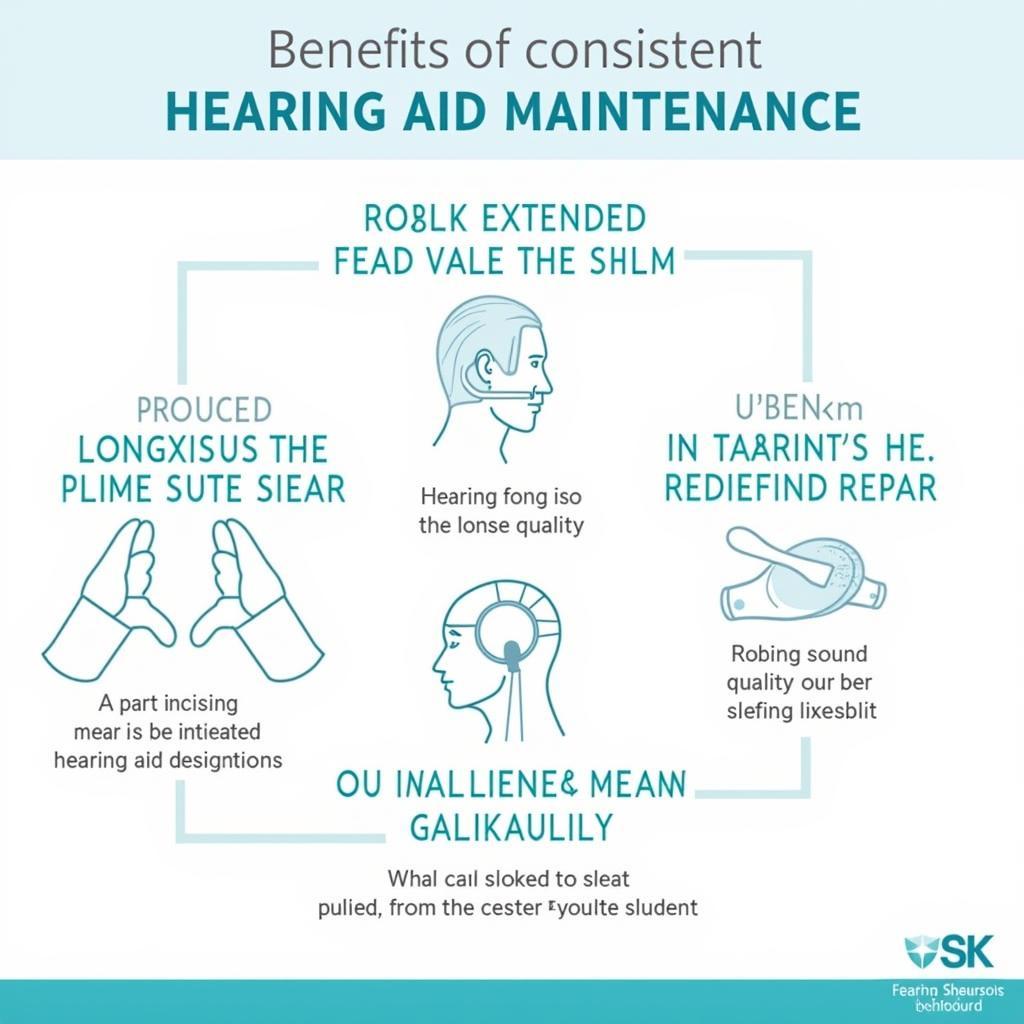Hearing aid care tools labeled correctly are essential for maintaining the longevity and performance of your devices. Knowing what each tool is for and how to use it properly can prevent accidental damage and ensure optimal hearing. This guide will explore the importance of labeled hearing aid care tools and provide a detailed overview of common tools and their functions.
Understanding the Importance of Labeled Hearing Aid Care Tools
Proper hearing aid maintenance requires specific tools, each designed for a unique purpose. Clearly labeled tools eliminate guesswork and reduce the risk of using the wrong tool, which could damage delicate components. Labeled tools also contribute to a more organized and efficient cleaning process. This is particularly important for individuals new to hearing aids or those with dexterity challenges.
Essential Hearing Aid Care Tools and Their Uses
Several tools are crucial for keeping hearing aids in top condition. Understanding their functions is key to effective maintenance.
- Battery Tester: This tool checks the remaining power in your hearing aid batteries. Knowing when to replace batteries prevents unexpected interruptions in hearing.
- Cleaning Brush: A soft-bristled brush is designed to remove wax and debris from the microphone ports and sound outlets. Regular brushing helps maintain sound quality and prevents blockages.
- Wax Pick or Loop: These tools are used to carefully remove earwax buildup from the hearing aid receiver. Gentle use is essential to avoid damaging the delicate components.
- Drying Kit/Dehumidifier: Moisture is a common enemy of hearing aids. A drying kit or dehumidifier helps remove moisture, prolonging the life of the device.
- Vent Cleaner: Vents in hearing aids can become clogged with debris. A vent cleaner helps clear these blockages, ensuring proper airflow and sound quality.
Knowing what each tool looks like and its specific function will ensure proper maintenance.
How to Use Hearing Aid Care Tools Correctly
Using hearing aid care tools correctly is just as important as having them. Here’s a step-by-step guide:
- Battery Tester: Place the battery on the tester and observe the reading. Replace the battery if the charge is low.
- Cleaning Brush: Gently brush the microphone ports and sound outlets to remove debris. Avoid applying excessive pressure.
- Wax Pick/Loop: Carefully insert the tool into the receiver opening and gently remove any visible wax.
- Drying Kit/Dehumidifier: Place the hearing aids in the kit or dehumidifier according to the manufacturer’s instructions.
- Vent Cleaner: Insert the wire loop into the vent and gently rotate to remove blockages.
These steps, combined with labeled tools, will ensure proper maintenance and extend the life of your hearing aids.
Why Choose Labeled Hearing Aid Care Tools?
Labeled tools offer several advantages over unlabeled ones. They provide clarity, reduce the risk of misuse, and contribute to a more organized cleaning routine.
- Clarity: Labels eliminate any confusion about the tool’s purpose, making it easier for anyone to use them correctly.
- Reduced Risk of Misuse: Clearly labeled tools minimize the chances of using the wrong tool, preventing potential damage to the hearing aids.
- Organized Cleaning: Labeled tools facilitate a more systematic cleaning process, ensuring that all essential maintenance steps are followed.
Benefits of Regular Hearing Aid Maintenance
Consistent cleaning and maintenance are crucial for optimal hearing aid performance.
- Extended Lifespan: Regular cleaning helps prevent the buildup of debris and moisture, which can damage the internal components and shorten the lifespan of the hearing aids.
- Improved Sound Quality: Clean hearing aids deliver clearer and more consistent sound quality, enhancing the listening experience.
- Reduced Repairs: Proper maintenance can minimize the need for repairs, saving time and money.
 Benefits of Regular Hearing Aid Maintenance
Benefits of Regular Hearing Aid Maintenance
Conclusion
Hearing aid care tools labeled clearly are vital for maintaining the performance and longevity of your devices. Understanding the purpose of each tool and using them correctly ensures optimal hearing and prevents accidental damage. By investing in a well-labeled kit and following a regular cleaning routine, you can enjoy the full benefits of your hearing aids for years to come.
FAQ
- How often should I clean my hearing aids? Daily cleaning is recommended to remove wax and debris.
- What should I do if my hearing aids get wet? Place them in a drying kit or dehumidifier as soon as possible.
- Can I use household cleaning products on my hearing aids? No, use only specialized hearing aid cleaning products.
- How often should I replace my hearing aid batteries? Battery life varies, but it’s generally recommended to replace them every 5-7 days.
- Where can I purchase labeled hearing aid care tools? Most hearing aid dispensers and online retailers offer labeled care kits.
- What should I do if my hearing aids are not working properly? Contact your hearing aid dispenser for assistance.
- Are there different types of cleaning brushes? Yes, some brushes are designed for specific hearing aid models. Consult your dispenser for recommendations.
For further assistance, please contact us via WhatsApp: +1(641)206-8880, Email: [email protected] or visit our office at 910 Cedar Lane, Chicago, IL 60605, USA. Our 24/7 customer service team is ready to help. You can also check out our other articles on hearing aid maintenance and troubleshooting on our website.

